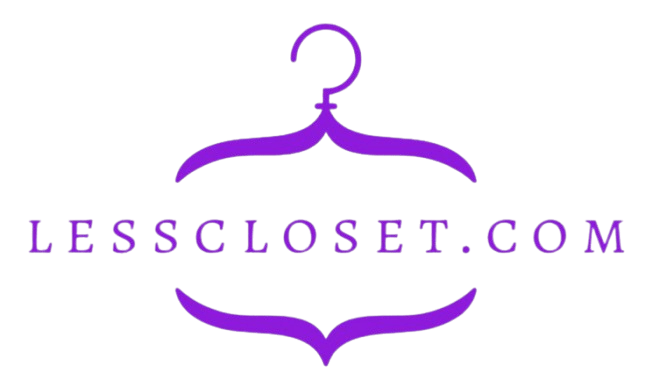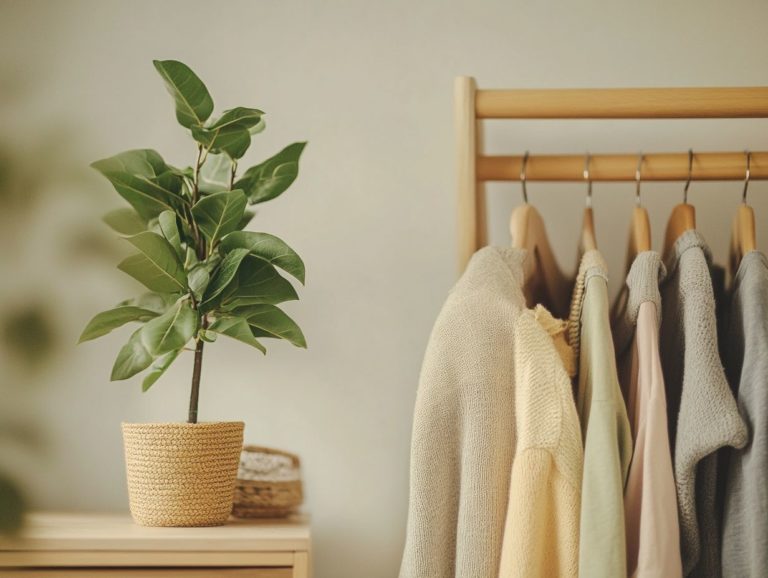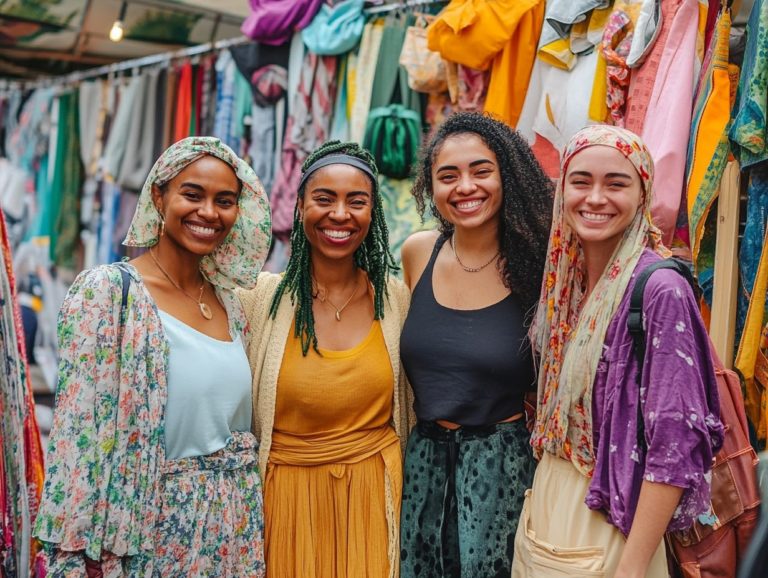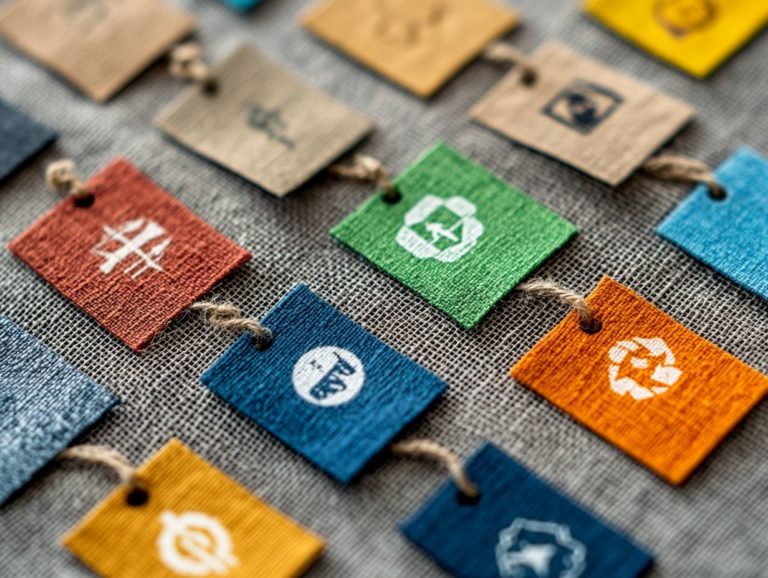How to Transition to a Sustainable Wardrobe
Today, people are more aware of their environmental impact. The fashion industry plays a significant role in shaping both ecological and social landscapes.
Fast fashion has transformed your wardrobe, but not without a hefty price tag. Let s dive into why choosing sustainable fashion is a game-changer for you and the planet!
From assessing your current wardrobe through a conscious wardrobe audit to shopping responsibly and upholding ethical practices, you ll find practical steps to curate a sustainable wardrobe that benefits both you and the planet.
Explore with us as we reveal the long-term advantages of making mindful fashion decisions, including the benefits of the 30 wears challenge.
Contents
- Key Takeaways:
- The Importance of Sustainable Fashion
- Steps to Transition to a Sustainable Wardrobe
- Practical Tips for Maintaining a Sustainable Wardrobe
- The Long-Term Benefits of a Sustainable Wardrobe
- Frequently Asked Questions
- What does it mean to transition to a sustainable wardrobe?
- Why should I transition to a sustainable wardrobe?
- How do I begin transitioning to a sustainable wardrobe?
- What are some sustainable materials and fabrics to look for?
- How can I make my current wardrobe more sustainable?
- What are some common mistakes to avoid when transitioning to a sustainable wardrobe?
Key Takeaways:

- Fast fashion harms our planet and society; switching to sustainable fashion is essential.
- Creating a sustainable wardrobe starts with evaluating what you already own and shopping ethically.
- Keep your wardrobe sustainable by caring for your clothes, supporting eco-friendly brands, and exploring secondhand options.
The Importance of Sustainable Fashion
Sustainable fashion is about fashion that is good for the environment and society. It addresses pressing issues like environmental degradation and social inequality. Advocates like Amy Powney and Livia Firth support this cause through organizations like Eco-Age. It s essential for discerning shoppers like you to embrace eco-friendly practices.
On Earth Day and beyond, acknowledging the value of sustainable fashion not only elevates your personal style but also enables you to make a positive impact on both the planet and society. Curating an ethical wardrobe that prioritizes quality over fast fashion aligns you with a movement that champions sustainability and responsibility within the fashion industry.
Environmental and Social Impacts of Fast Fashion
Fast fashion is infamous for its harmful environmental and social effects, driving pollution, waste, and exploitation within the clothing industry. The frantic production cycles and unethical practices deplete resources at an alarming rate and stifle clothing recycling initiatives, ultimately undermining the very principles of a circular economy. A circular economy is an economic system aimed at eliminating waste and promoting the continual use of resources.
This situation leads to severe repercussions for ecosystems and communities worldwide. Organizations like the Waste and Resources Action Programme highlight the critical need for sustainable practices that encourage responsible consumption and waste reduction.
Often, consumers overlook the hidden costs, such as labor exploitation in countries where production is outsourced. Initiatives from entities like Ninety Percent aim to shift this narrative by redistributing a portion of their profits to charitable causes.
By choosing these alternatives and advocating for better practices, you can make a meaningful contribution to a healthier planet and a fairer society.
Steps to Transition to a Sustainable Wardrobe
Transitioning to a sustainable wardrobe is a thoughtful journey that starts with evaluating your current clothing collection. Conducting a wardrobe audit allows you to pinpoint items that don’t align with sustainable practices.
By embracing the role of a conscious shopper, you can curate a collection of high-quality garments that serve as investment pieces, enhancing both your personal style and the well-being of the environment.
Evaluating Your Current Wardrobe
Evaluating your current wardrobe through a comprehensive audit is the first step toward embracing fashion that is better for the environment. This process allows you to assess which items truly align with your values and lifestyle.
By examining the quality of your clothing and their potential for longevity, you can start identifying pieces that genuinely contribute to an ethical and sustainable wardrobe. This journey goes beyond a simple sorting of clothes; it demands thoughtful consideration of each item’s fabric, construction, and how they integrate into your daily life, elevating the significance of choosing quality over quantity.
Focus on those classic pieces that withstand the ebb and flow of trends, ensuring they can be worn at least 30 times before considering an exit. Adopting care methods like proper washing techniques and suitable storage can significantly prolong the lifespan of your garments.
Ultimately, prioritizing these sustainable practices not only enhances your personal style but also promotes a more responsible approach to consumerism, embedding principles of a circular economy. To learn more about this, check out what a sustainable wardrobe looks like, a system designed to minimize waste by reusing resources.
Shopping Ethically and Responsibly
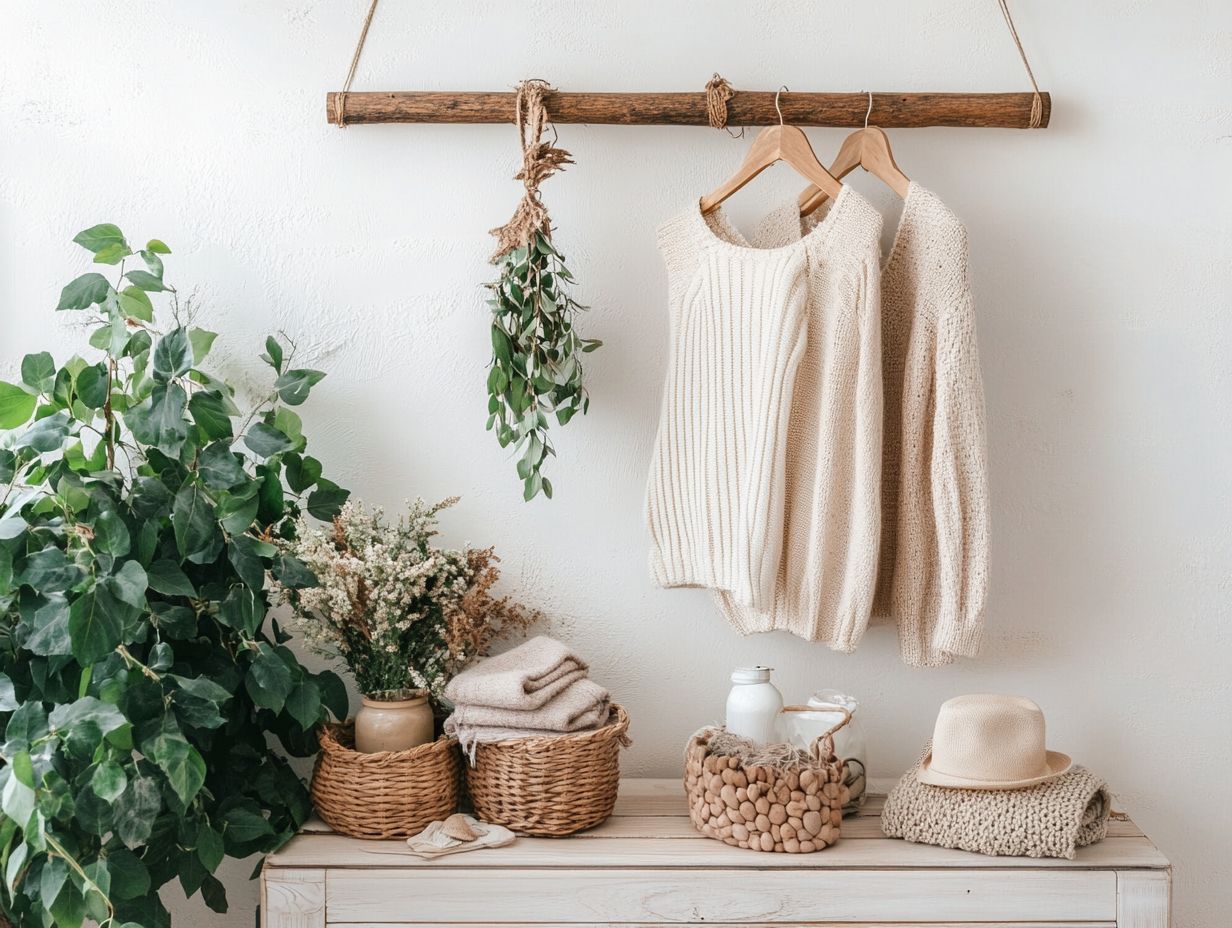
Shopping ethically and responsibly is essential for crafting an ethical wardrobe, ensuring that every purchase aligns with sustainable brands and responsible practices.
By embracing the role of a conscious shopper who prioritizes vintage pieces or considers rental fashion options, you can significantly minimize your environmental footprint while elevating your personal style with insights from the minimalist’s guide to eco-friendly fashion.
One effective strategy is to explore platforms like The RealReal and 1stDibs, where you ll find a curated selection of pre-owned luxury items. This allows you to invest in high-quality fashion without feeding into the fast fashion cycle.
Incorporating brands such as Stella McCartney, renowned for their dedication to ethical production, further harmonizes your wardrobe with sustainable practices.
Experimenting with rental fashion opens up a world of styles for special occasions, reducing waste and making it easier for you to indulge in fashion without compromise. Together, these methods foster a more thoughtful approach to your personal style, giving you the power to make choices that reflect your values.
Creating a Capsule Wardrobe
Creating a capsule wardrobe is a brilliant way for you to streamline your fashion choices while embracing sustainable principles. It inspires you to choose versatile wardrobe essentials that you’ll love wearing!
This minimalist approach not only simplifies your daily outfit decisions but also promotes a more sustainable lifestyle by reducing clothing waste.
By intentionally curating timeless pieces, you can revel in the joy of mixing and matching, allowing for endless combinations without the clutter of an overcrowded closet. To build your ideal capsule wardrobe, focus on essential items like classic jeans, a tailored blazer, and basic tees that never go out of style.
Choosing sustainable brands such as Reformation and Everlane ensures that your selections are not only stylish but also responsibly made. This thoughtful assembly enhances your personal style while aligning with your commitment to ethical consumption, making it easier than ever to dress well while caring for the planet.
Practical Tips for Maintaining a Sustainable Wardrobe
Maintaining a sustainable wardrobe calls for thoughtful strategies that center on clothing care, prolonging the life of your garments, and ultimately minimizing waste. By mastering the art of clothing repair, recycling unwanted items, and embracing the principles of a circular economy, you can cultivate an eco-friendly and sustainable wardrobe that not only reflects your style but also respects the planet.
Act now! Every small step you take can have a huge impact on our planet.
Proper Clothing Care and Repair
Proper clothing care and repair are essential practices if you want to extend the life of your garments and maintain a sustainable fashion approach that prioritizes quality. By investing time in learning simple repair techniques and practicing mindful clothing care, you can significantly reduce the need for fast fashion purchases and promote sustainability.
Maintaining quality clothes involves a few key methods. Start with gentle washing using eco-friendly detergents. Employ proper drying techniques and implement thoughtful storage solutions. Choosing brands that focus on sustainable materials, like Ecover or Seventh Generation, can truly make a difference.
For mending small tears or loose seams, having a handy toolkit with a needle, thread, or even a sewing machine will empower you to carry out repairs with ease. Consider hand-washing delicate garments to preserve their integrity. Store seasonal clothing in breathable bags to keep them safe from damage.
Embracing these practices not only helps prolong the life of your wardrobe but also showcases your commitment to ethical fashion. This encourages others to consider sustainable fabrics for your capsule wardrobe as well.
Supporting Sustainable Brands
Supporting sustainable brands is essential for building an ethical wardrobe, empowering you as a conscious shopper to contribute to a more responsible fashion industry. By choosing to purchase from brands that prioritize eco-friendly practices and embrace the principles of reusing and recycling, you actively create demand for sustainable fashion solutions.
The choices you make in the marketplace resonate far beyond your individual purchases. They influence global production standards and encourage larger corporations, like Levi’s under Chip Bergh’s leadership, to reassess their practices.
Take Patagonia, for example. It stands out not just for its commitment to environmental activism but also for its transparent supply chain. Then there s Pact Apparel, which emphasizes organic materials and fair labor practices setting a high bar for ethical manufacturing. Similarly, House of Dagmar champions Scandinavian sustainable luxury by focusing on responsible sourcing.
Supporting these brands drives the industry towards greener practices. Your choice matters!
Secondhand and Upcycling Options
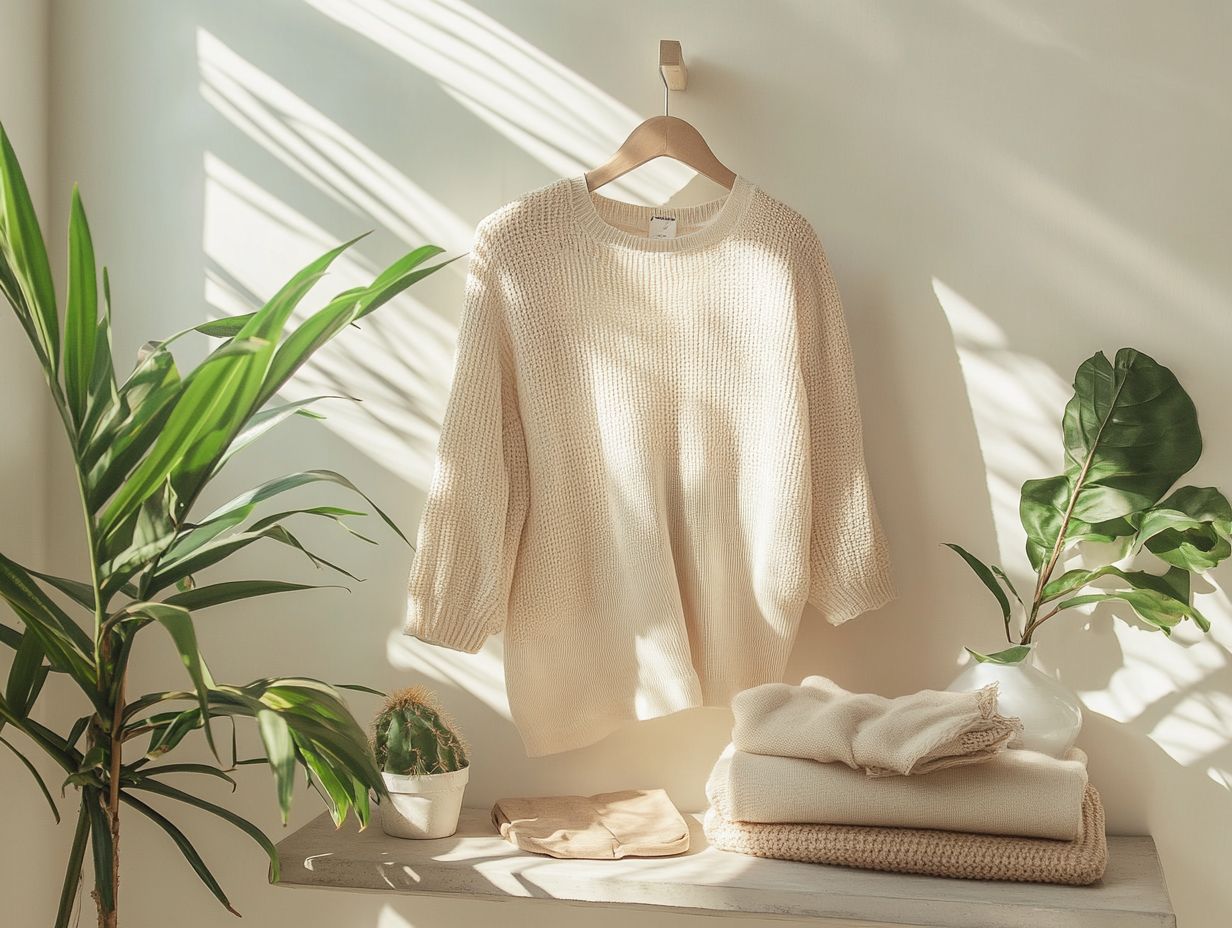
Exploring secondhand and upcycling options is a fantastic way to cultivate a sustainable wardrobe while uncovering unique fashion treasures, like vintage pieces that carry their own stories. By choosing second-hand clothing and embracing upcycling practices, you re not just reducing waste; you re actively contributing to a more circular economy.
Incorporating these practices into your routine can be both enjoyable and rewarding. Platforms like Vestiaire Collective and The RealReal present curated selections of high-quality pre-owned items, enabling you to discover statement pieces without breaking the bank. When you re on the hunt for quality, it s crucial to examine materials and craftsmanship. This ensures that your wardrobe stands the test of time.
With a touch of creativity, upcycling can turn even the most basic garments into stylish statements. Imagine transforming a vintage scarf into a chic top or customizing an oversized jacket. This creative approach can really elevate your personal style and cultivate a distinctive sense of identity in every outfit you wear.
The Long-Term Benefits of a Sustainable Wardrobe
The long-term benefits of a sustainable wardrobe extend beyond just looking good; they offer substantial environmental and personal impacts that resonate with conscious shoppers like you.
By investing in quality pieces that stand the test of time, you re not just curating a unique style; you re also making a positive contribution to the planet’s health and well-being.
Start exploring secondhand options today! Check out these zero waste fashion tips for a sustainable closet and join the movement for sustainable fashion!
Environmental and Personal Impact
The environmental impact of a sustainable wardrobe is truly profound; it minimizes waste and conserves resources. This practice helps make the planet healthier while providing you with a sense of fulfillment and alignment with your ethical values. By embracing sustainable practices, you re not just dressing yourself; you’re contributing to a healthier planet and cultivating a wardrobe that genuinely reflects who you are.
This commitment shrinks your carbon footprint associated with fast fashion. It also supports ethical brands championed by visionaries like Amy Powney and Livia Firth. Every choice you make from selecting eco-friendly materials to prioritizing timeless pieces over fleeting trends can lead to significant reductions in textile waste. Additionally, exploring the benefits of building a capsule wardrobe sustainably can further enhance your impact.
Creating a sustainable wardrobe encourages you to embrace quality over quantity. This gives the power to moment through mindful shopping, inspiring those around you to take similar steps and fostering a community committed to sustainable living and broader sustainability goals.
Frequently Asked Questions
What does it mean to transition to a sustainable wardrobe?
Transitioning to a sustainable wardrobe means choosing clothing and accessories carefully. It involves reducing the environmental impact of your wardrobe and supporting ethical and sustainable practices in the fashion industry.
Why should I transition to a sustainable wardrobe?
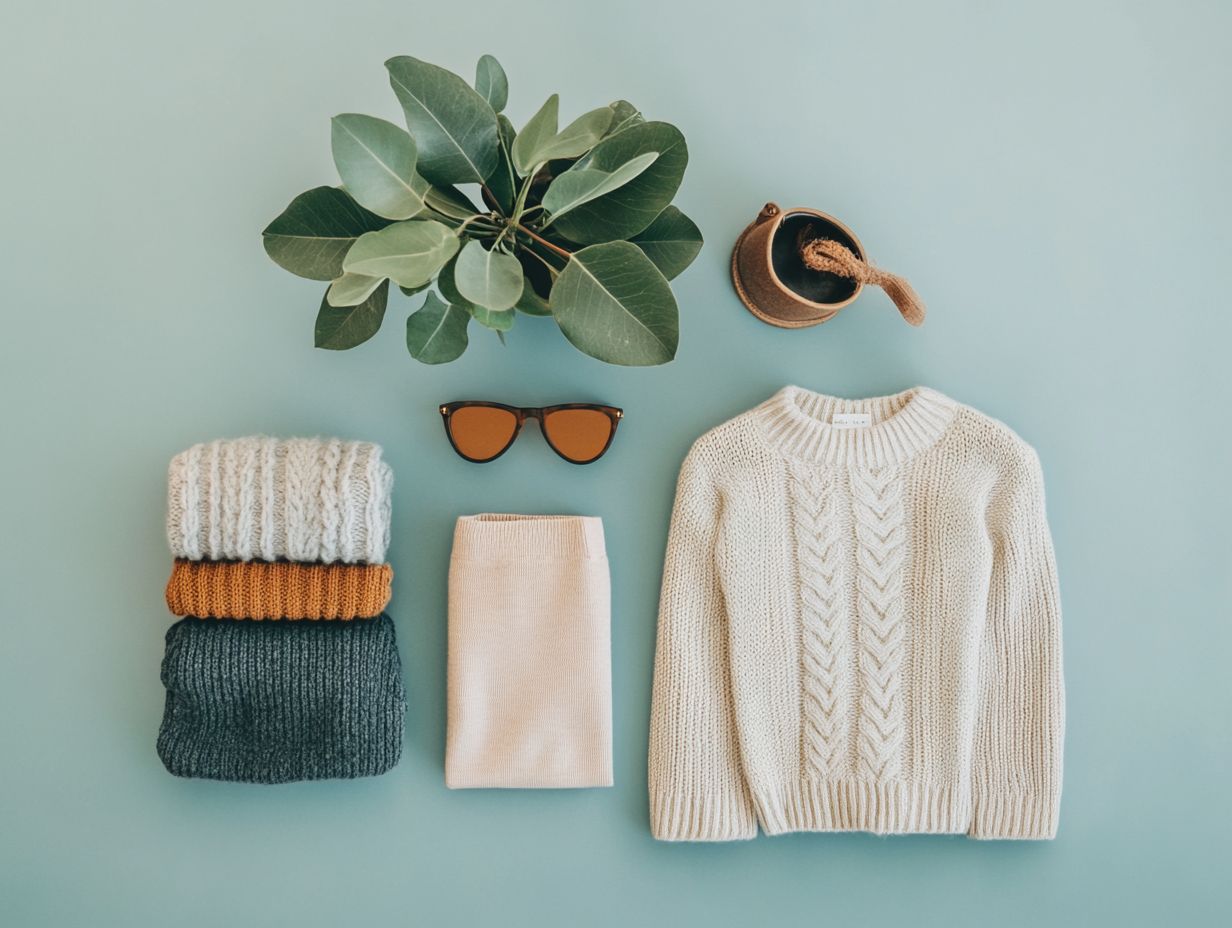
Transitioning to a sustainable wardrobe has numerous benefits. It helps reduce your carbon footprint, which is the amount of carbon dioxide your actions release into the environment. It also supports ethical and fair labor practices and promotes a more circular economy. This transition allows you to align your values with your fashion choices and make a positive impact on the planet.
How do I begin transitioning to a sustainable wardrobe?
Wondering where to start with sustainable fashion? Here are a few steps to begin transitioning to a sustainable wardrobe:
- Reassess your current wardrobe.
- Educate yourself about sustainable fashion.
- Make more conscious and intentional purchases.
- Support sustainable and ethical brands.
- Consider alternative options like thrifting and clothing swaps.
What are some sustainable materials and fabrics to look for?
When shopping for sustainable clothing, look for materials such as organic cotton, linen, hemp, and Tencel. These materials are produced using more eco-friendly processes and have a lower environmental impact. It’s also important to avoid materials like polyester, which is made from non-renewable resources and contributes to microplastic pollution.
How can I make my current wardrobe more sustainable?
There are a few ways to make your current wardrobe more sustainable:
- Declutter and donate or sell any items you no longer wear.
- Mend and repair items instead of immediately replacing them.
- Incorporate sustainable practices into your daily routine, such as washing clothes in cold water and air-drying them.
What are some common mistakes to avoid when transitioning to a sustainable wardrobe?
One common mistake is falling for ‘greenwashing’ when companies use misleading marketing tactics to make their products seem more sustainable than they actually are. It’s important to do your research and look for certifications like Fair Trade or GOTS. Another mistake is buying too many items at once; it’s better to make gradual changes and invest in high-quality, timeless pieces. Lastly, don’t forget to properly dispose of any old or damaged clothing consider recycling or upcycling instead of throwing them away.
Begin your journey to a sustainable wardrobe today. Every small change counts!
